
Chemistry: What's Your Atomic Number?
Clip: Special | 1m 4sVideo has Closed Captions
How do scientists organize all the elements in the universe?
Elements are organized into the periodic table. Find out how scientists classify elements and what the atomic number means.
Problems playing video? | Closed Captioning Feedback
Problems playing video? | Closed Captioning Feedback
Science Trek is a local public television program presented by IdahoPTV
Major Funding by the Laura Moore Cunningham Foundation and the Idaho National Laboratory. Additional Funding by Sparklight, the Friends of Idaho Public Television and the Corporation for Public Broadcasting.

Chemistry: What's Your Atomic Number?
Clip: Special | 1m 4sVideo has Closed Captions
Elements are organized into the periodic table. Find out how scientists classify elements and what the atomic number means.
Problems playing video? | Closed Captioning Feedback
How to Watch Science Trek
Science Trek is available to stream on pbs.org and the free PBS App, available on iPhone, Apple TV, Android TV, Android smartphones, Amazon Fire TV, Amazon Fire Tablet, Roku, Samsung Smart TV, and Vizio.

Science Trek
Science Trek is a place where parents, kids, and educators can watch short, educational videos on a variety of science topics. Every Monday Science Trek releases a new video that introduces children to math, science, technology, engineering, and math (STEM) career potentials in a fun, informative way.(SCIENCE TREK MUSIC) JOAN CARTAN-HANSEN, HOST: Elements are organized into what's called the periodic table.
But how did they decide what went where?
When organizing elements, you start with their atoms.
Atoms are made up of protons, neutrons, and electrons.
The number of protons in one atom of an element is its atomic number.
Hydrogen has one proton, so its atomic number is one.
Carbon atoms have six protons, so its atomic number is six.
Elements also each have a unique atomic mass.
The atom's mass primarily comes from the protons and neutrons in the atom's nucleus.
Elements are then organized by periods and groups.
Elements in the same period have similar numbers of what's called, atomic orbitals, the space where electrons exist.
The elements in a group share physical and chemical properties.
That may seem pretty complicated, so just remember that the periodic table is put together based on the number of protons and how the electrons in each element are organized.
For more information about Chemistry, check out the Science Trek website.
You'll find it at ScienceTrek.org.
Video has Closed Captions
Clip: Special | 1m 4s | What is the most abundant element in the universe? (1m 4s)
Providing Support for PBS.org
Learn Moreabout PBS online sponsorship
- Science and Nature

Explore scientific discoveries on television's most acclaimed science documentary series.

- Science and Nature

Capturing the splendor of the natural world, from the African plains to the Antarctic ice.












Support for PBS provided by:
Science Trek is a local public television program presented by IdahoPTV
Major Funding by the Laura Moore Cunningham Foundation and the Idaho National Laboratory. Additional Funding by Sparklight, the Friends of Idaho Public Television and the Corporation for Public Broadcasting.
